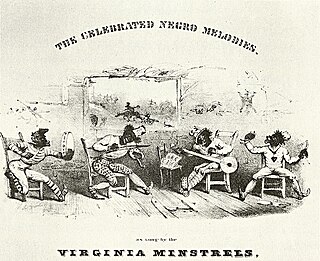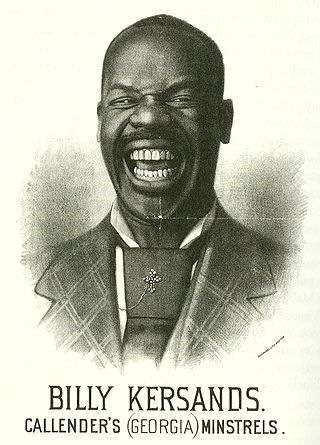
"Jump Jim Crow", often shortened to just "Jim Crow", is a song and dance from 1828 that was done in blackface by white minstrel performer Thomas Dartmouth "Daddy" Rice. The song is speculated to have been taken from Jim Crow, a physically disabled enslaved African-American, who is variously claimed to have lived in St. Louis, Cincinnati, or Pittsburgh. The song became a 19th-century hit and Rice performed it all over the United States as "Daddy Pops Jim Crow".

The minstrel show, also called minstrelsy, was an American form of theater developed in the early 19th century. The shows were performed by mostly white actors wearing blackface makeup for the purpose of comically portraying racial stereotypes of African Americans. There were also some African-American performers and black-only minstrel groups that formed and toured. Minstrel shows stereotyped blacks as dimwitted, lazy, buffoonish, cowardly, superstitious, and happy-go-lucky. Each show consisted of comic skits, variety acts, dancing, and music performances that depicted people specifically of African descent.

Master Juba was an African-American dancer active in the 1840s. He was one of the first black performers in the United States to play onstage for white audiences and the only one of the era to tour with a white minstrel group. His real name was believed to be William Henry Lane, and he was also known as "Boz's Juba" following Dickens's graphic description of him in American Notes.

"Turkey in the Straw" is an American folk song that first gained popularity in the 19th century. Early versions of the song were titled "Zip Coon", which were first published around 1834 and performed in minstrel shows, with different people claiming authorship of the song. The melody of "Zip Coon" later became known as "Turkey in the Straw"; a song titled "Turkey in de Straw" with different music and lyrics was published in 1861 together with the wordless music of "Zip Coon" added at the end, and the title "Turkey in the Straw" then became linked to the tune of "Zip Coon".
"Jimmy Crack Corn" or "Blue-Tail Fly" is an American song which first became popular during the rise of blackface minstrelsy in the 1840s through performances by the Virginia Minstrels. It regained currency as a folk song in the 1940s at the beginning of the American folk music revival and has since become a popular children's song. Over the years, several variants have appeared.

"Dixie", also known as "Dixie's Land", "I Wish I Was in Dixie", and other titles, is a song about the Southern United States first made in 1859. It is one of the most distinctively Southern musical products of the 19th century. It was not a folk song at its creation, but it has since entered the American folk vernacular. The song likely rooted the word "Dixie" in the American vocabulary as a nickname for the Southern U.S.

"Old Dan Tucker," also known as "Ole Dan Tucker," "Dan Tucker," and other variants, is an American popular song. Its origins remain obscure; the tune may have come from oral tradition, and the words may have been written by songwriter and performer Dan Emmett. The blackface troupe the Virginia Minstrels popularized "Old Dan Tucker" in 1843, and it quickly became a minstrel hit, behind only "Miss Lucy Long" and "Mary Blane" in popularity during the antebellum period. "Old Dan Tucker" entered the folk vernacular around the same time. Today it is a bluegrass and country music standard. It is no. 390 in the Roud Folk Song Index.

Billy Kersands was an African-American comedian and dancer. He was the most popular black comedian of his day, best known for his work in blackface minstrelsy. In addition to his skillful acrobatics, dancing, singing, and instrument playing, Kersands was renowned for his comic routines involving his large mouth, which he could contort comically or fill with objects such as billiard balls or saucers. His stage persona was that of the dim-witted black man of the type that had been popularized in white minstrel shows. Modern commentators such as Mel Watkins cite him as one of the earliest black entertainers to have faced the dilemma of striking a balance between social satire and the reinforcement of negative stereotypes.
Bryant's Minstrels was a blackface minstrel troupe that performed in the mid-19th century, primarily in New York City. The troupe was led by the O'Neill brothers from upstate New York, who took the stage name Bryant.
"Clare de Kitchen" is an American song from the blackface minstrel tradition. It dates to 1832, when blackface performers such as George Nichols, Thomas D. Rice, and George Washington Dixon began to sing it. These performers and American writers such as T. Allston Brown traced the song's origins to black riverboatmen. "Clare de Kitchen" became very popular, and performers sometimes sang the lyrics of "Blue Tail Fly" to its tune.
"De Wild Goose-Nation" is an American song composed by blackface minstrel performer Dan Emmett.
"Johnny Roach" is an American song written by blackface minstrel composer Dan Emmett. The song was first published in 1859. The lyrics tell of a slave who has escaped to the Northern United States, who laments his lost plantation house and realizes that he really belongs in the South:

William M. Whitlock was an American blackface performer. He began his career in entertainment doing blackface banjo routines in circuses and dime shows, and by 1843 he was well known in New York City. He is best known for his role in forming the original minstrel show troupe, the Virginia Minstrels.
"Ole Bull and Old Dan Tucker" is a traditional American song. Several different versions are known, the earliest published in 1844 by the Boston-based Charles Keith company. The song's lyrics tell of the rivalry and contest of skill between Ole Bull and Dan Tucker. The song also satirizes the low pay earned by early minstrel performers: "Ole Bull come to town one day [and] got five hundred for to play."
"Miss Lucy Long", also known as "Lucy Long" as well as by other variants, is an American song that was popularized in the blackface minstrel show.

Francis Marion Brower was an American blackface performer active in the mid-19th century. Brower began performing blackface song-and-dance acts in circuses and variety shows when he was 13. He eventually introduced the bones to his act, helping to popularize it as a blackface instrument. Brower teamed with various other performers, forming his longest association with banjoist Dan Emmett beginning in 1841. Brower earned a reputation as a gifted dancer. In 1842, Brower and Emmett moved to New York City. They were out of work by January 1843, when they teamed up with Billy Whitlock and Richard Pelham to form the Virginia Minstrels. The group was the first to perform a full minstrel show as a complete evening's entertainment. Brower pioneered the role of the endman.
"Mary Blane", also known as "Mary Blain" and other variants, is an American song that was popularized in the blackface minstrel show. Several different versions are known, but all feature a male protagonist singing of his lover Mary Blane, her abduction, and eventual death. "Mary Blane" was by far the most popular female captivity song in antebellum minstrelsy.

John Diamond, aka Jack or Johnny, was an Irish-American dancer and blackface minstrel performer. Diamond entered show business at age 17 and soon came to the attention of circus promoter P. T. Barnum. In less than a year, Diamond and Barnum had a falling-out, and Diamond left to perform with other blackface performers. Diamond's dance style merged elements of English, Irish, and African dance. For the most part, he performed in blackface and sang popular minstrel tunes or accompanied a singer or instrumentalist. Diamond's movements emphasized lower-body movements and rapid footwork with little movement above the waist.
"I'm Alabama Bound" is a ragtime melody composed by Robert Hoffman in 1909. Hoffman dedicated it to an M. T. Scarlata. The cover of its first edition, published by Robert Ebberman, New Orleans, 1909, advertises the music as "Also Known As The Alabama Blues" which has led some to suspect it of being one of the first blues songs. However, as written, it is an up-tempo rag with no associated lyrics. The song has been recorded numerous times in different styles—both written and in sound recordings—with a number of different sets of lyrics.









